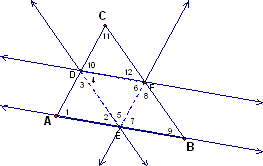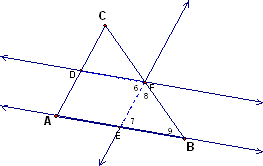
First recall that a Medial Triangle is the triangle constructed from the 3 midpoints of the sides of the original triangle. The question that now arises it what kinds of relationships are there between these (two) triangles - are they similar, congruent, what's the area comparison, and ratio of their perimeters. The following page explores these relationships for all types of triangles, i.e.. equilateral, isosceles, and right, as well as for any given triangle.
The following items will be compared in this write-up with the following triangle as the referenced triangle.
Congruency? Similarity?
Length of Segments? Perimeter
Area?

Are the four triangles created from the construction of the medial triangle congruent?
If we had an equilateral triangle, this would be obviously
true. For AD @
One way to show this is from our previous congruencies, DE
@
What if the triangle isn't equilateral though? What can we say about the congruency of these triangles now? Let's take a look at just two segments of the medial triangle. Since the segments that create the medial triangle are parallel to the segments of the original triangle, respectively, we can conclude congruency of some of the angles. (NOTE: The number depicts the angle in reference and the word angle as well as the value of degrees will be left out for simplicity of the argument.)


Figure 1 Figure 2


Figure 3 Figure 4
From the Alternating Angle Theorem, the following angles are congruent:
2 @
3 @
6 @
7 @
10
Additionally, since the sum of the degrees of a triangle is
180, we have the following:
(1) 1 + 2 + 3 = 180
(2) 4 + 5 + 6 = 180
(3) 7 + 8 + 9 = 180
(4) 10 + 11 + 12 = 180
We can now substitute in into the above equations, the congruencies
we found. Take for example equation (1):
1 + 4 + 5 = 180. From equation (2), we know that 1
must be congruent to 6. Likewise, for (3), we have
6 + 5 + 9 = 180, which implies 9 @
4. And for (4), we have 11 @
But do we have congruent triangles? Since
DE @
Similarity of the triangle ABC with the medial triangle? We
showed above that the angles of triangle ABC are congruent to
angles of the medial triangle DEF. (need to verify order)
Back to Top

What about the relationship between the length of DE in relation to AB? We now need to draw upon the relationship of similarity that we just proved. Similar triangles have their segments in the same ratio. For example:
DF = DE = FE
AB CB
CA
Recall that AB = AE + EB, AC = AD + DC; and BC = BF + FC.
And from the above congruencies, we know that
AE @
DF
AD @
EF
From the above ratios - we can substitute in for the following:
DF =
DF =
DF = 1
AE+EB 2(AE)
2(DF) 2
So the relationship between the lengths of the sides of the medial triangle to the larger triangle is 2: 1 (i.e if AB = 4, then DF = 2)
Therefore, the perimeter of the Medial, P(DEF) = (DE + DF +
EF) and the perimeter of larger triangle, P(ABC) = (AB + BC +
CA). Substituting in our ratio length,
P(ABC) = (2DF) + (2DE) + (2FE) = 2(DF + DE + EF). So the perimeter
of the larger triangle is twice as large as the perimeter of Medial
triangle.
Back to Top
What about the area of the smaller triangle to the original? Now that we know the length comparison, we can just plug our ratio in the Area of a Triangle Equation : A= 1/2(b*h).
First let's draw the altitudes for our triangles (height).

For the original triangle we have A 1/2
(AB * CG) and for the Medial triangle we have
A = 1/2(DF*EH).
From our ratio of lengths (2:1) though,, we can deduce that the
area of the smaller triangle is one fourth that of the original:
A = 1/2*[1/2(AB*CG)] = 1/4(AB*CG)